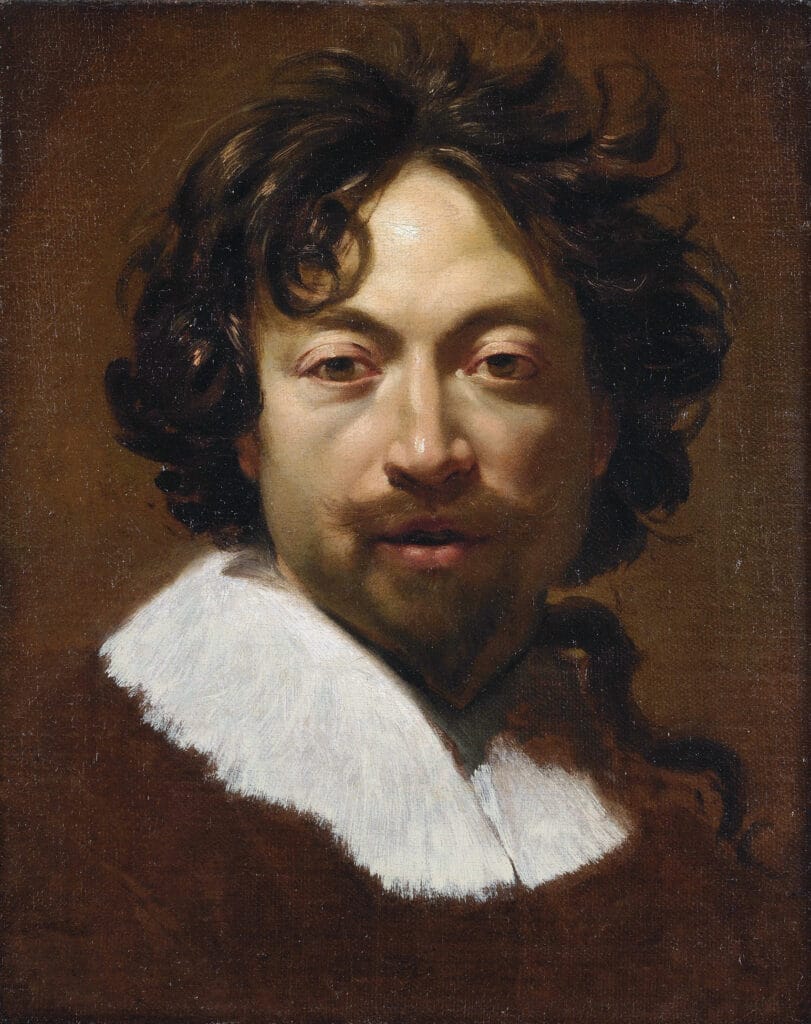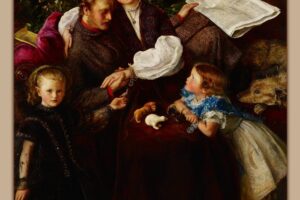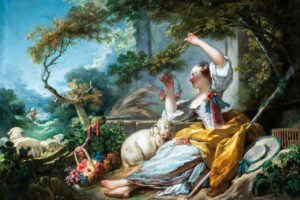The Muses Urania and Calliope – Simon Vouet, c. 1634
In a world bathed in twilight gold, inspiration meets intellect. Simon Vouet, masterful painter of the French Baroque, paints a scene both serene and powerful, where beauty and wisdom intertwine. His c. 1634 painting, The Muses Urania and Calliope, reveals not merely two mythic figures but an enduring symbol of artistic and celestial insight.
The Scene Before Us
Seated gracefully beneath classical columns and a gentle sky, two elegant muses pause in conversation. Urania, muse of astronomy, crowned with delicate stars, rests thoughtfully upon a celestial sphere. Her robes of azure and white mirror the heavens she governs, and she gazes with quiet wisdom toward her companion.
Calliope, muse of epic poetry, wears robes of pink and golden yellow, and clasps a scroll gently—words waiting to be written or perhaps just spoken. Her eyes lift, thoughtful, questioning. The exchange between them is subtle: a gentle touch, an exchanged look, a shared silence.
Around them, cherubs drift softly from clouds, offering wreaths of laurel—tokens of honor, achievement, and creativity itself. Their presence underscores the divine yet intimate moment unfolding between the two muses.
The Deeper Meaning
Vouet invites us to reflect upon the marriage of inspiration and intellect, poetry and science, art and reason. He suggests that creativity thrives not alone, but through dialogue, through gentle exchange, through companionship.
The painting suggests something timeless: wisdom flourishes when the arts meet knowledge, and beauty deepens through understanding. The celestial sphere beneath Urania’s hand and the scroll held firmly by Calliope are not merely symbols; they are invitations—to look outward into the universe and inward into human stories.
Vouet’s delicate brushwork and harmonious color palette echo this thoughtful tranquility. The gentle draping of fabric, the serene softness of expressions, the subtle play of light and shadow all whisper quietly: greatness is not loud. It speaks gently, listens closely, and grows in silence and contemplation.
A Moment Caught in Time
Vouet’s muses seem eternal, suspended in timeless conversation. We don’t know what words might pass between them—what secrets, what revelations—but we sense their importance. Perhaps they speak of destiny, or the mysteries of stars, or poetry’s power to capture human truths.
Yet the beauty of the painting is precisely in its silence. It reminds us that inspiration often arrives quietly—in a shared glance, in a thoughtful touch, in the meeting of two minds beneath the vastness of an evening sky.
About Artist

Simon Vouet (1590–1649) was a highly influential French painter who was instrumental in bringing the Baroque style to France. After spending over a decade in Italy, he returned to Paris as the court painter to King Louis XIII, and his work set the standard for French art for many years. He is known for his large-scale religious and mythological works, as well as his elegant portra
Artistic Style and Italian Influence
Vouet’s style is a blend of Italian and French traditions. During his time in Rome, he was influenced by the dramatic light of Caravaggio and the classical grandeur of the Carracci brothers. He developed a refined and decorative style characterized by:
- Softer Tenebrism: Unlike the stark contrasts of Caravaggio, Vouet used a more subdued and graceful approach to light and shadow.
- Vibrant Color: His paintings are known for their rich and decorative palette, with elegant figures and flowing draperies.
- Classical Grace: His figures often have an idealized, almost classical beauty, and his compositions are well-balanced and harmonious.
Vouet’s return to France marked a turning point in French art. He established a large and highly productive workshop that trained many of the next generation of French painters, including Charles Le Brun, who would go on to dominate the style of the Palace of Versailles.
Artwork Profile
Vouet’s art is a testament to his versatility and skill, ranging from monumental altarpieces to intimate portraits.
- The Muses Urania and Calliope (c. 1634): This beautiful painting is a prime example of Vouet’s mature, decorative style. The work depicts two of the nine Muses: Urania, the Muse of astronomy, and Calliope, the Muse of epic poetry. They are shown in elegant, harmonious poses, surrounded by celestial and scholarly objects. The painting’s luminous colors, graceful forms, and overall sense of serene harmony made it a highly sought-after work and a clear expression of the classical Baroque style.
- A Young Man Playing a Flute (c. 1625): This is a work from his Italian period, showing the clear influence of Caravaggio. The figure is seen in a powerful chiaroscuro, with a single light source highlighting his face and hands. It demonstrates Vouet’s early mastery of dramatic lighting.
Vouet’s work bridged the gap between the Italian Baroque and the development of a distinctively French classical style, making him a central figure in 17th-century European art history.



